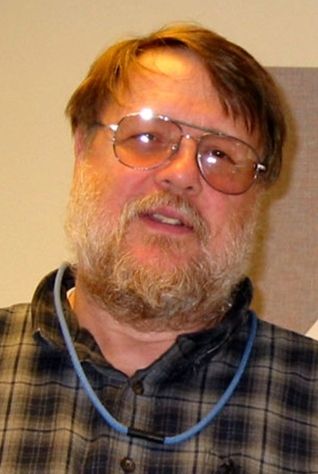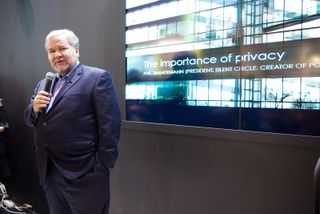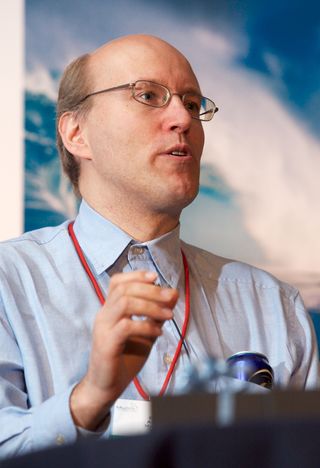We've all heard of Tim Berners-Lee, the inventor of the World Wide Web. And many of you will be familiar with Håkon Wium Lie, the inventor of CSS.
But despite the web dominating everyone's lives, many of its most important pioneers are still not household names in 2016 – even in some households where web designers live!
So to address the balance a little here, we've pulled together five hidden heroes from the annals of web design. There are plenty more names to honour besides these of course, so feel free to add your favourite unsung heroes in the comments below.
01. Brendan Eich

Today's web would look pretty drab and be hugely lacking in interactivity without JavaScript. And yet Brendan Eich took just 10 days to create it in 1995, while working for Netscape.
And that's not all. In 1998, Eich co-founded the Mozilla project with Mitchell Baker, as a way to manage open-source contributions to the Netscape source code. That eventually transformed into the Mozilla Foundation, which launched Firefox. And without Firefox, Microsoft's Internet Explorer might have ended up dominating the web, condemning generations of web designers to endless browser hacks to make their sites function properly.
Born in Pittsburgh, Eich, now 55, played a central role in Mozilla's evolution, eventually becoming CEO of Mozilla Corporation in 2014. However, he was forced to step down shortly after, when a gay rights campaign targeted his support for California Proposition 8, which made same-sex marriage illegal.
Eich has continued to shake up the web as CEO of Brave Software, whose open-source web browser includes a micropayments system that offers a choice between viewing selected ads or paying websites not to display them.
Get the Creative Bloq Newsletter
Daily design news, reviews, how-tos and more, as picked by the editors.
02. Ray Tomlinson

Born in New York in 1941, Ray Tomlinson's name should really sit alongside Berners-Lee in the internet hall of legends, as he did something pretty darned amazing. He invented email.
Way back in 1971, Tomlinson was working at R&D company Bolt Beranek and Newman – now Raytheon BBN Technologies – he pioneered the first system able to send mail between users on different hosts connected to the ARPANET, a forerunner to today's internet.
To achieve this, he used the @ sign for sending email. Tomlinson picked the symbol because it was little-used at the time and, as he liked to say, "It's the only preposition on the keyboard."
The first email was sent between two machines that were side-by-side. It contained a message that Tomlinson, who died this March aged 74, described as "something like QWERTYUIOP". Incredibly, the first people to use his new system didn't think it was that big a deal. In fact, according to a 1998 profile in Forbes magazine, Tomlinson told a colleague: "Don't tell anyone! This isn't what we're supposed to be working on."
With the advent of personal computers, email went on to fundamentally change the way humanity communicates, with more than a billion and a half users spanning the globe. All the more amazing considering, according to Raytheon spokeswoman Joyce Kuzman, "it wasn't an assignment at all, he was just fooling around".
03. Howard 'Ward' Cunningham

Hailing from Michigan City, Indiana, Howard Cunningham is known as 'Ward' to his fans, handily distinguishing him from the dad in Happy Days. And while you may not have heard of him, you've almost certainly benefited from what he invented: the Wiki.
Ward started developing WikiWikiWeb in 1994 and installed it on the website of his software consultancy Cunningham & Cunningham in March 1995. Wiki is the Hawaiian word for "quick" and in the context of web design, it's come to mean a website that provides collaborative modification of its content and structure directly from the web browser.
The wiki has transformed the web, facilitating the crowd-sourced creation of online knowledge bases on an epic scale, from OpenStreetMap to the Family History Research Wiki, and most notably the all-encompassing Wikipedia and Wiki Answers.
But when asked in a 2006 interview with internetnews.com whether he considered patenting the Wiki concept, Cunningham replied that he thought it "just sounded like something that no one would want to pay money for."
Like many great web pioneers, Ward has his own 'law'. According to former Intel executive, Steven McGeady, Cunningham advised him in the early 1980s, "The best way to get the right answer on the Internet is not to ask a question; it's to post the wrong answer." McGeady dubbed this Cunningham's law.
Cunningham wasn't satisfied with his invention, though, and continued to work to improve it. In 2011, inspired by Github, he created Smallest Federated Wiki, a tool for wiki federation, which brought the concept of forking to wiki pages. As Wired put it: "The radical idea of the wiki was to put an edit button on every page. The radical idea of the federated wiki is to put a 'fork' button on every page."
You can learn more about Cunningham at his rather spartan personal site, a tribute to the simplicity of the early web.
04. Phil Zimmermann

Born in Camden, New Jersey, Phil Zimmermann, 52, is the creator of the most widely used email encryption software in the world.
In 1991, he wrote the popular Pretty Good Privacy (PGP) program, and shared it, together with its source code, through public FTP for download. It was the first widely available program implementing public-key cryptography.
While most early web pioneers gave us their time and energy, Zimmerman sacrificed a lot more than that. As a result of his work, US Customs made him the target of a criminal investigation for allegedly violating the Arms Export Control Act. (The government had long classified cryptographic software as a "munition", making it subject to arms trafficking export controls.)
The government finally dropped its case without indictment in 1996, and Zimmermann founded PGP Inc, which was acquired by Network Associates in 1997. The user manual for PGP contains the following prescient warning: "Today, email can be routinely and automatically scanned for interesting keywords, on a vast scale, without detection. This is like driftnet fishing."
Edward Snowden's revelations two decades later showed just how much the US secret services has exploited this data vulnerability to spy on its own citizens and other. Suitably enough, when the former NSA contractor reached out to journalists to blow their cover, he did so using PGP.
Zimmermann's Law chillingly states: "The natural flow of technology tends to move in the direction of making surveillance easier, and the ability of computers to track us doubles every 18 months."
05. David Axmark

Database software may seem a dull subject to some, but without MySQL there wouldn't be much of a web to look at today. And co-founder David Axmark from Sweden, 54, has been intimately involved in its development from the very start.
A relational database management system, MySQL got its name by combining the first syllable of co-founder Michael Widenius with the initials of "Structured Query Language". It's since become widely used in a host of open-source projects that require a full-featured database management system, including WordPress, Drupal, Joomla, TYPO3, MODx, phpBB and MyBB. MySQL is also used in many high-profile websites, including Facebook, Twitter, Flickr, YouTube and non-search parts of Google
Given his immense contribution to the modern web, Axmark might be forgiven for becoming a little arrogant. And yet everyone agrees he's one of the nicest people in web design. Fritz Nelson of Information Week described him as a "humble entrepreneur" with "zero ego, maximum success, achieved from a place of pure personal passion and the observation of need rather than blatant commercialization".
Axmark has been involved with free software since 1980, and in 2005 launched OrangeHRM, a company providing open source human resource management software. And in 2012 he teamed up with the other MySQL founders, Michael "Monty" Widenius and Allan Larsson, to create the MariaDB Foundation. This is a community-developed fork of MySQL, created due to concerns over its acquisition by Oracle.

Thank you for reading 5 articles this month* Join now for unlimited access
Enjoy your first month for just £1 / $1 / €1
*Read 5 free articles per month without a subscription

Join now for unlimited access
Try first month for just £1 / $1 / €1
Tom May is an award-winning journalist and editor specialising in design, photography and technology. Author of the Amazon #1 bestseller Great TED Talks: Creativity, published by Pavilion Books, Tom was previously editor of Professional Photography magazine, associate editor at Creative Bloq, and deputy editor at net magazine. Today, he is a regular contributor to Creative Bloq and its sister sites Digital Camera World, T3.com and Tech Radar. He also writes for Creative Boom and works on content marketing projects.
